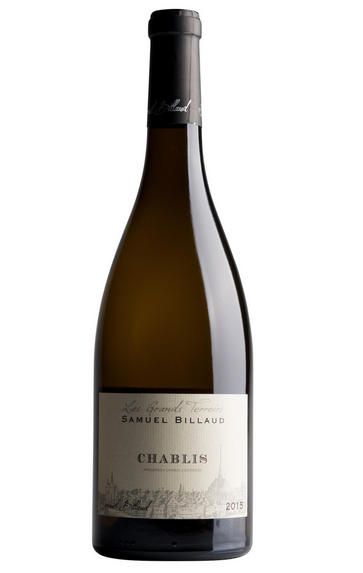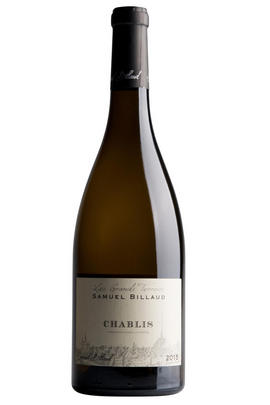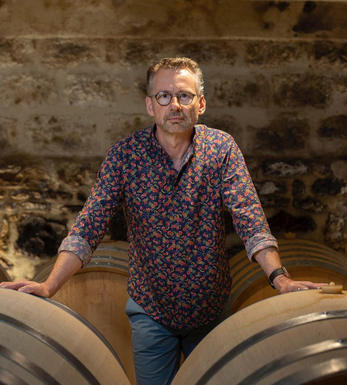
2022 Chablis, Samuel Billaud, Burgundy

Critics reviews
A blend of three great sites, Les Pargues (35 year old vines), Bas de Chapelot (40), and Les Quarts (90 year old), and some Fontenottes. Bright pale colour. Excellent tension, even bitterness. This definitely needs more elevage so will be bottled later than the Petit Chablis. Some riper notes before a much more saline finish. Impeccable and totally Chablis.
Drink 2025 - 2028
Jasper Morris MW, Inside Burgundy (June 2023)
The 2022 Chablis Grands Terroirs comes from the usual three parcels. The nose offers yellow plum and verbena, touches of chalk emerging with aeration. The palate has real "zing" on the entry, sharp and pointed, taut and linear, revivifying the senses with impressive concentration on the finish. Citrus-fresh, very saline - superb.
Drink 2024 - 2032
Neal Martin, Vinous (July 2023)
Pretty forceful, direct acidity here. Classic Chablis style. Will age. Comes from two plots situated on the left bank of the Serein, with one positioned below Montée de Tonnerre. They are fermented and kept separate before blending. Mostly hand-harvested.
Drink 2024 - 2028
Andy Howard MW, Decanter (October 2023)
About this WINE

Samuel Billaud
The brilliantly talented Samuel Billaud was finding family politics hard going, so he has now founded his own wine label in Chablis separate from Domaine Billaud-Simon.
As far as we are concerned, the talent lies in the person and not the history, so we are delighted to have taken a small position with Samuel’s own wines. He does not own the vineyards but he does manage them, as well as crushing the grapes and vinifying the wines. We can certainly recognise his style in these offerings.

Chablis
Chablis lies further north than the rest of Burgundy, located about halfway between Beaune and Paris; it’s actually not all that far from Champagne. The wines here – exclusively whites from Chardonnay – differ in style from other white Burgundies: they tend towards steeliness and flintiness.
The Chablis region is an island of vines lying amid the forests and pastures of the Yonne département. In the heart of Chablis, the soils are marl (clay-limestone) of a particular kind – Kimmeridgian – containing traces of marine fossils. For many, the classic aroma and flavour profile of Chablis is built around seashell and an iodine, marine character imparted by the soil.
As elsewhere in Burgundy, there’s a hierarchy in Chablis. Grand Cru represents the top tier, although it accounts for just one per cent of overall Chablis production. The Grand Cru vineyards rise above the eponymous town in an impressive sweep, sloping south. These are sunny sites, ranging in elevation from 100 to 250 metres above sea level. The wines are deep and powerful, benefitting hugely from bottle age after release. The best examples can age for up to 20 years. Over time, their colour evolves from greenish gold to a light yellow, and they develop real aromatic complexity.
Unlike the other tiers, it’s not uncommon for Grand Cru Chablis to see new oak. As a result, its flavour profile is perhaps more comparable to the Côte d’Or than the rest of Chablis. For something more classically “Chablis”, there’s the Premiers Crus. Style and quality can vary, depending on the climat and the producer. Whether floral or more mineral, the best examples are seriously impressive and represent the hallmark style of the region – they can also offer real value for money. These are structured wines with the capacity to age for 10 to 15 years.
The next tier – accounting for most of the region’s output – is labelled simply as “Chablis”. These are steely, clean and lean whites with aromas of green apples and lemon, intended for early drinking. As ever in Burgundy, there are exceptions: well-made examples by top growers from vineyards abutting the Premiers Crus can be age-worthy.
Finally, there’s Petit Chablis: everyday wines, generally from vineyards planted on higher slopes. Petit Chablis accounts for around one-fifth of all Chablis produced. These wines typically come from Portlandian limestone, known to produce a fruitier, simpler wine than Chablis.

Chardonnay
Chardonnay is often seen as the king of white wine grapes and one of the most widely planted in the world It is suited to a wide variety of soils, though it excels in soils with a high limestone content as found in Champagne, Chablis, and the Côte D`Or.
Burgundy is Chardonnay's spiritual home and the best White Burgundies are dry, rich, honeyed wines with marvellous poise, elegance and balance. They are unquestionably the finest dry white wines in the world. Chardonnay plays a crucial role in the Champagne blend, providing structure and finesse, and is the sole grape in Blanc de Blancs.
It is quantitatively important in California and Australia, is widely planted in Chile and South Africa, and is the second most widely planted grape in New Zealand. In warm climates Chardonnay has a tendency to develop very high sugar levels during the final stages of ripening and this can occur at the expense of acidity. Late picking is a common problem and can result in blowsy and flabby wines that lack structure and definition.
Recently in the New World, we have seen a move towards more elegant, better- balanced and less oak-driven Chardonnays, and this is to be welcomed.


Buying options
Add to wishlist
Description
As ever, this comes from three highly regarded village vineyards – Bas de Chapelot, Pargues and Cartes – all of which are adjacent to Premiers Crus. This is classical with oyster shell and citrus fruit on the nose. The palate is juicy and saline, nicely wrapped in orchard fruit before finishing with a tingling freshness.
Drink 2024 - 2029
Berry Bros. & Rudd
wine at a glance
Delivery and quality guarantee